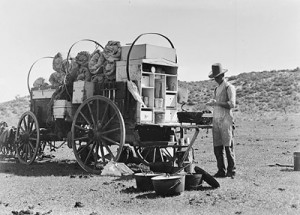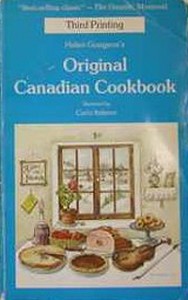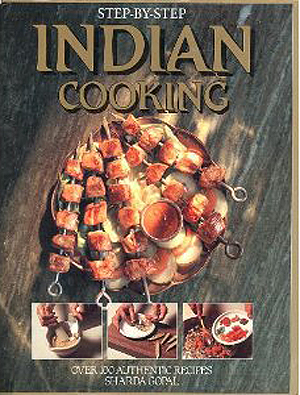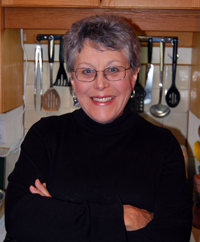
I had a friend whose first own-apartment culinary adventure was a roast chicken. In high panic, she called her mother in New York, who said that tin foil over the bird would prevent dryness. Not having tin foil, she used Saran Wrap, and not having confidence in the chicken, she wrapped the whole bird. Several times. The chicken came out lovely and brown, with a beautiful glaze of impenetrable baked plastic wrap. So much for bookless cooks.
If you can read, you can cook. I learned to cook first from my mother, peeling hard-boiled eggs for picnics when I was ten, and making dinner by the time I was sixteen. We were a foodie family—my dad once ordered a barrel of live lobsters to be shipped from Nova Scotia to Ottawa. When I later came across ten years’ issues of the original Gourmet Magazine, I more or less ate them up. And learned about food.
Some cookbooks are for inspiration, some are for practical duty in the kitchen, and some do triple duty for soul, hands and appetite. Revelstoke has a great selection of new and old cookbooks, in every category, at Castle Joe and Grizzly Books. Lots of other places also carry books about food and nutrition as well as cookery magazines: PT Market, Mountain Goodness, Pharmasave and People’s, Coopers and Southside, Energy Matters and Eco-Cents. And Third Street Café sells its own house cookbook.
The Revelstoke Museum and Archives is asking for recipes for their newest in a fund-raising series of community-inspired collections. The next will be published in time for Christmas, and will be about Celebrations — Christmas, Easter, Thanksgiving. The Museum is asking for recipes with short (1-5 lines) memory stories.
A cookbook makes a great gift — enduring, useful, decorative and compact — but it helps to know what you’re buying. Publishers categorize cookbooks, and it’s useful to tap into these in order to build a collection that is both inspiring and practical — or if you’re a total novice, to grab something to help you stumble through your first dinner with some sort of panache.
This annotated list may prove useful — the research (thanks to Gwen for the suggestion) sent me on some real memory trips, and gave me some good ideas as well. Cookbooks make great bedtime reading, by the way — short items conducive to happy states of mind, and if you can resist trotting off to the fridge, eventually soporific.
Classic and Basics
The Joy of Cooking, 75th anniversary edition. My personal Bible, an amazing compendium of recipes, food lore and information, measurement equivalents and substitutions. If there’s just one book everyone should have, it’s Irma Rombauer’s Joy, and I can tell you from experience that if you have only one cookbook this will see you through sickbed snacks to weddings for 500. Updated and totally dependable. Grizzly Books, $39.99.
Julia Child’s Mastering the Art of French Cooking, Volume I, $37.00 at Grizzly Books. If you saw the movie, read the book — it’s a whole lot better than the script, but the film did show how much testing and expertise goes into a cookbook. Utterly reliable, this book set a new standard with its detailed, ample descriptions and authenticity of recipes. I still read this book as bedtime comfort, delighting in the clear elegant prose and the insight into how a fine mind wraps her head around calf’s foot jelly.
M.F.K. Fisher, The Art of Eating. First published in 1937, then by Faber and Faber in the UK with an introduction by W.H. Auden. Castle Joe has a somewhat rare copy for a bargain price of $18.00 for the 1990 edition with an introduction by Clifton Fadiman (MacMillan.) If Gourmet taught me how to cook, M.F.K. Fisher taught me how to think about food as a hallmark of living well. This is not gourmet small-g cooking — Fisher’s chapter How to Cook A Wolf is about living on a poet’s income during the 1930s in Europe, and includes how to make soap, mouthwash and pincushions.
At the other end of the price scale is The Pocket Cook Book, $4.00 at Castle Joe. Repeatedly published in 54 editions between 1942 and 1966, this tiny well-worn book contains 1300 recipes including one for Cheddar Pennies that I long to make, and good instructions for canning and preserving.
Cooking in Colour: 700 Recipes for Every Occasion. $12 at Castle Joe Books. This large hardcover book is useful and timeless. A colour photo for each recipe. Instructions are simple, using things you might already have at home, and also surprisingly contemporary, for a used book — goat’s cheese salad, for instance, with celery and walnuts, and sausages in cider sauce, which looks so good I was tempted to buy the book myself.

Historical interest
Start with two books by B.M. Barss at $9.95 each, at Grizzly — Cowboys and Chuckwagons and At the Ranch House. Home-on-the-range recipes such as beer can biscuits, often for a crowd. Plus quotes from cowboys along the lines of “a few dry beans in yer pocket ‘n’ you’re good on the trail fer a week.” The photographs are of great interest, and these alone are worth the price.
Home Management. 1934. A compendium of British home-making—everything from women’s rights to owning property in their own name, apparently new info to women in the U.K. in the mid-30’s, the rules for poker, and to how to make badminton cup. Don’t you yearn to know more about minced collops (what is this?) and bullock’s heart (to be served with good gravy and red-currant jelly)? At Castle Joe, $25.00.
Helen Gougeon’s Original Canadian Cookbook, 1975, reprinted from the 1955

edition with some updates. $8.00 at Castle Joe. French-Canadian pea soup, tourtière, and other plain, sustaining fare of our grandmothers. The recipes work, many are familiar to anyone over 35, and they are good.
Economical Cookery and Menus for Every Day in the Year. Undated, but 1930s, or whenever 4 apples cost 3 pence and beef was a shilling a pound in London. Actually does include 365 daily menus written for large strong men doing outdoor work and hungry for offal, suet, and rennet. Reminder of time when customer service was nonexistent: for Roast Hare, for instance: “Skin, paunch, well wash and remove the eyes, but allow the ears to remain.” Be nice to your butcher. Castle Joe, $18.00.
Apparently the most valuable of Castle Joe’s collection is the title 3 Meals a Day, $50, by Jessie Read, Canadian Home Economist and once Food Editor for the long-defunct Toronto Telegram. This is a rare find, internet research tells us. Classic Canadian cookery, including a still useful section with recipes on cooking for two.
Community cookbooks
Every cause has had its cookbook for over 100 years, it seems. The best known is perhaps The Best of Bridge, now available (and far beyond fund-raising) as The Complete Best of Bridge, Vol. I, in a binder that appears cumbersome but does allow the pages to lie completely flat on the counter. 350 recipes. Many people own nothing else, and consistently produce wholesome, appealing and delicious meals. $29.95 at Grizzly Books. A number of older and more local community books by various women’s clubs, dating mainly from the 1950s and 60s, can be had at Castle Joe Books — homey, hearty and time-tested recipes from local kitchens — great value.
And of course, our own Revelstoke Museum, as mentioned above, offers a selection of cookbooks from local sources: A Taste of Elegance ($19.95) and the same title with sub Second Helpings, and also the Legacy of Country Dining ($17.50) with contributions from Arrow Lakes, 12-Mile and Big Bend among others.

Chefs’ Secrets
Jamie, Nigel, Nigella, Martha — Julia set the bar awful high, but these guys are trying hard to make the leap. A TV show seems to be the current benchmark for entry into this club, so watch for Kendra to publish her own mac’n’cheese. Some of these are the best cookbooks — the recipes tested assiduously, selected for mass appeal and ease of constitution, and the talk full of personal eccentricity of one sort or another — though Nigella’s appeal is — at least for one guy I know —l ess cerebral, and not a bit culinary.
My friend Helen chose from Grizzly’s shelves the Barefoot Contessa’s Back to Basics, $40. Simple, fresh, healthy recipes, with a good mix of dishes, nice photos, simple ingredients. The woman is brilliant, and so is her food. I always find something I want to make. She also proves that a few extra pounds are just fine if there’s a great smile on top.
The best sellers at Grizzly these days are the Whitewater duo — Whitewater Cooks at Home ($34.95) and Whitewater Cooks: Pure, Simple and Real Creations (29.95). These lovely books by chef Shelley Adams of the Fresh Tracks Café at Nelson’s Freshwater Winter Resort are beautifully illustrated and strong on recipe integrity. Another chef-restaurant book is Rebar: Modernfoodcookbook ($29.95) with its outstanding light but delectable chocolate cake.
My own favourite is Trish Magwood and her book Dish, not available in Revelstoke but it should be. Trish is a Toronto caterer whose recipes are outstanding and very reliable. she is young, hip and through her catering business very attuned to what people want these days especially for parties. No listing could be complete without Hollyhock and some mention of the Moosewood books—vegetarian but generically useful. I can also recommend from experience books by Jamie Oliver, Nigel Slater and Nigella Lawson. Grizzley Books carries the first two.
Local and Ethnic cookbooks

Ethnic, global, crossover, fusion — the influences from afar intertwine with local foods. It’s hard to find reliable ethnic cookbooks — partly because as Goldie showed me some months ago, some of the world’s best cooking has no written recipes. This is changing, although Western cooking methods don’t always measure up to the 3-hour low-heat glazing of onions that’s at the base of many Indian dishes, for instance. Step-by-Step Indian Cooking ($25.95 at Grizzly) makes an effort to show Westerners how to cook. Be warned though, the ingredients will not be ones you may find on your shelves.
If you’re uncertain how much you’ll use one a book featuring traditions other than your own, try Vegetables the Chinese Way by Stephen Yan ($2.50 at Castle Joe) — I bought the other one, Chinese Recipes, and find that the only odd ingredient is tapioca starch, rather than corn starch. Also available is How to Cook and Eat in Chinese for $7.00, as well as the hard-cover, encyclopaedic Thai Food by David Thompson ($24.00).
Cookery books for, by and with Children
These are in the target audience category of books, and very popular, from the look of Grizzley bookshelves. First of all, for up-and-coming grads, there are The New Students’ Cookbook: fab food to feed your face ($11.95 at Grizzle y) in which the reliance on canned items may be realistic rather than deplorable as a tactic to get students away from dinner-from-a-dispenser habits. The Students’ Veggie Cookbook in the same series looks healthier but lacks the jazzy title.
I like Grow It and Cook It with Kids, ($24.94, Grizzle y) Amanda Grant’s large compendium gives “5 ways to cook it” for lots of veggies and garden produce. Recipes will appeal to older rather than younger children. My favorite is called Children’s Cookbook, by Fiona Watt. The recipes are simple, will appeal to young appetites, and Stephen Cartwright’s illustrations are intelligent and appealing rather than merely cute. Plus almost any new cook can benefit from the step-by-steps. There’s also Kids Cooking: A Slightly Messy Manual, $16.95, also with good illustrations by Jim M’Guinness that seem to be for kids 5-10, but I think the foods would appeal to kids over 10. Love in Spoonfuls: fast and easy ways to make nutritious food for your baby ($23.95 at Grizzle y) is a book I’d like to give every new mother — how to avoid Heinz in 160 terrific pages.
Used books for kids are quite a good idea seeing how fast kids outgrow everything, and Castle Joe can offer Betty Crocker’s New Boys and Girls Cookbook for $5.00, as well as Giggles to Gumdrops with great ideas for serving food to children and a title alone that’s worth the price of $4.00.Castle Joe also has a rare copy of Barbie’s Easy-As-Pie Cookbook, a collector’s item for $25.00, presumably valuable for the quite delightful commentary in fictional form about Barbie and her kitchen efforts.
Lifestyle and more
The categories continue—perhaps the other best seller these days are what are called lifestyle cookbooks, including books on health and nutrition. And diets. There are so many of these I’m not going to even begin to review them: vegan, gluten-free, vegetarian, low Glycemic Index (G.I.) (my own preferred menu orientation) and every way you can think of to consume less fo the bad stuff and more of the good. Michael Pollan’s Food Rules appears here. The Gluten Free Bible by Penguin ($17.00 at Grizzly) is a current best-seller.
There are also single ingredient books: how to cook salmon, beef, game, how to cook with beer and wine, with spices and herbs, and 365 Ways to Cook Quinoa, a best seller at Grizzly. Another group is made up of seasonal and holiday books: Christmas cooking, summer recipes, and so on. Techie books include recipes for a hot pot, using a food processor, a juicer. These often come with the appliance. Another category consists of books about cooking methods. Some masquerade under more generic titles, so it’s best to read tables of content, or leaf through, before buying. Who would have guessed that The Complete Trail Food Cookbook ($24.95 at Grizzley Books) is mainly about how to dehydrate food in order to backpack it, with recipes for those dried bits of everything from oats to cottage cheese. Also in the lifestyle category are cookbooks for hiking, camping, sailing, RVing and gardening.
So while publishers agonize over whether Kindle and its ilk will replace print, most of us will continue to by cookbooks. You’re on-line and so am I, but print is my staple, and cookbooks remain an anomoly in the publishing world, with growing sales and an ever-increasing number of titles, authors, and – yup — readers.




